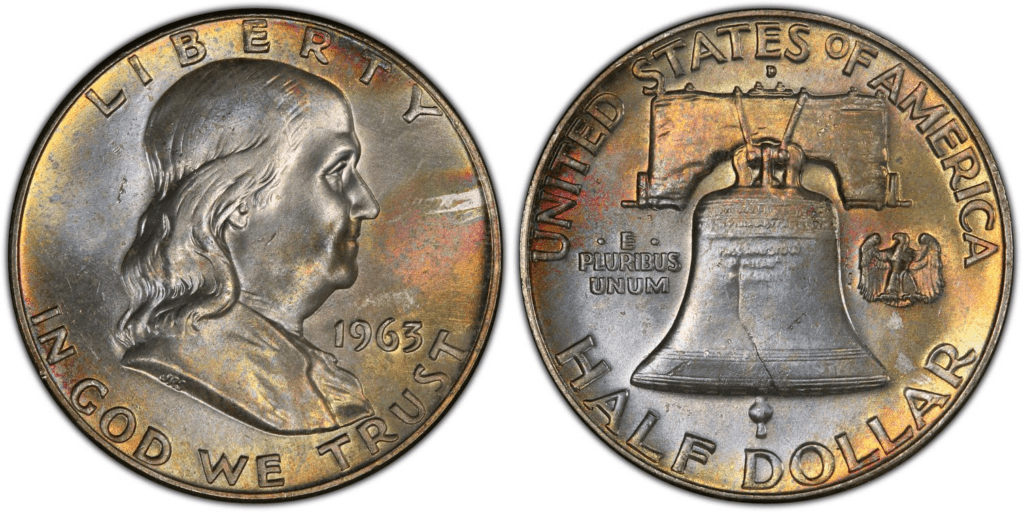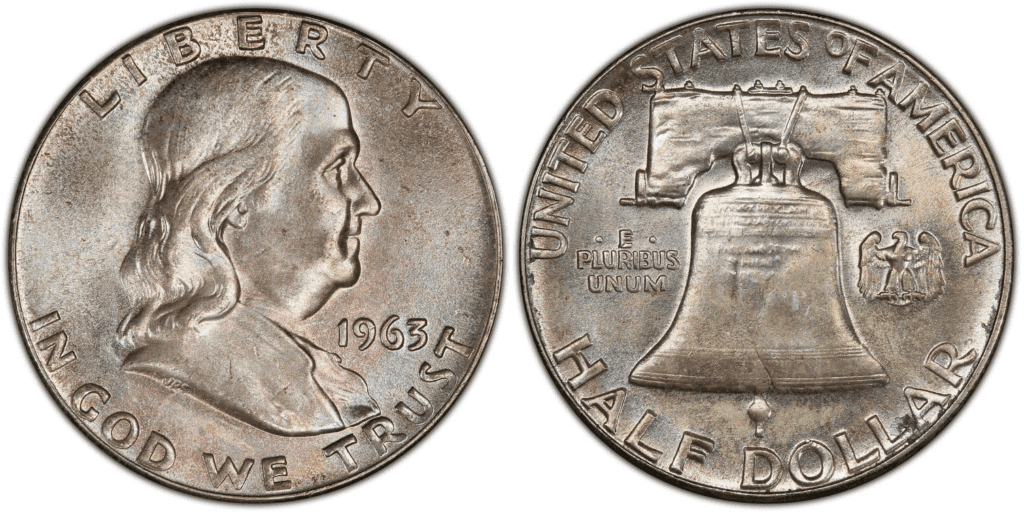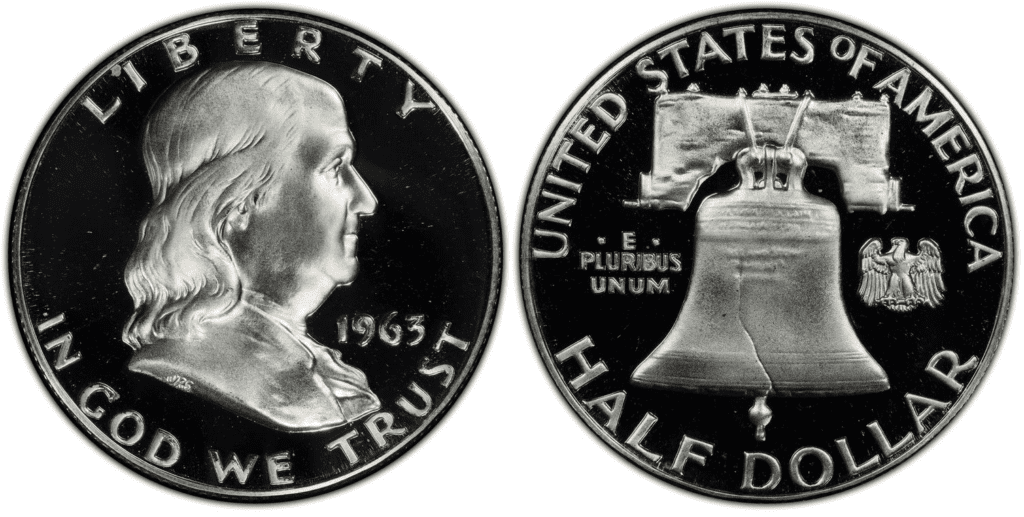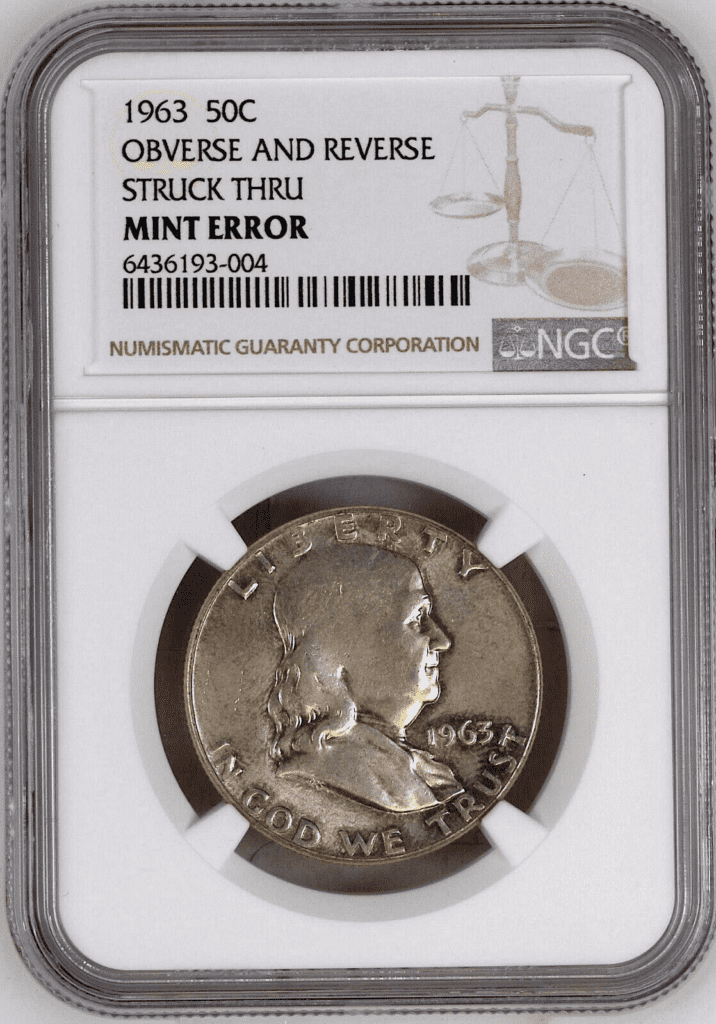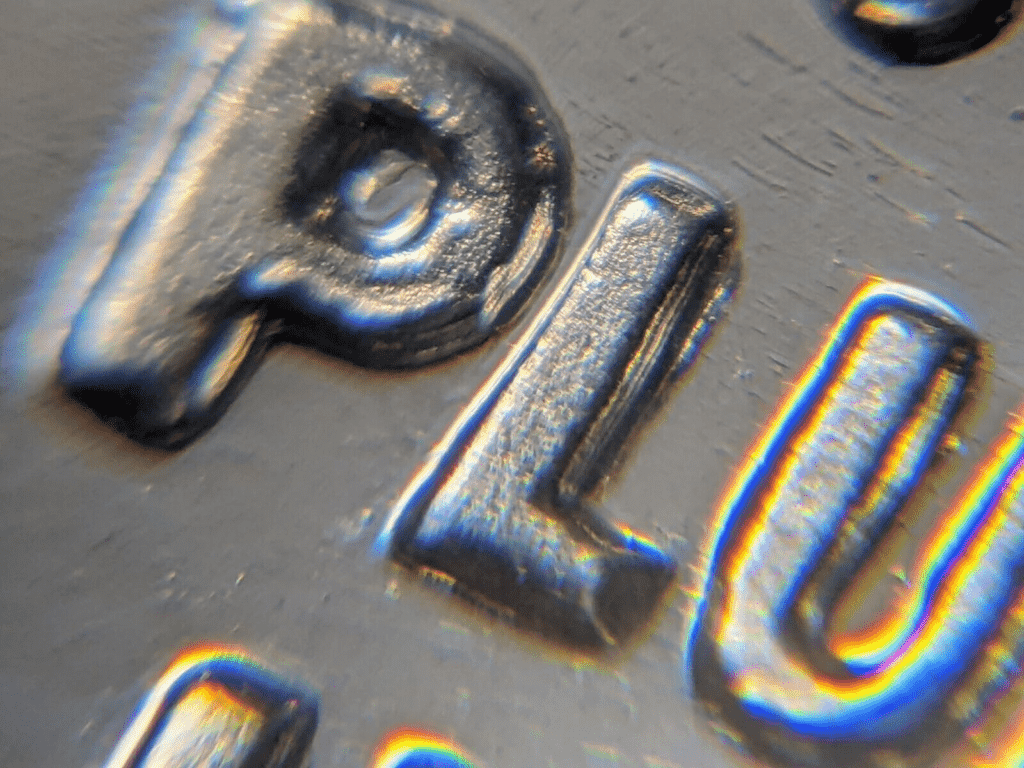What Is the 1963 Franklin Half Dollar Made Of?
The 1963 Franklin half-dollar is made of 90% silver and 10% copper. Specifically, it contains 0.36169 troy oz.
The 1963 Franklin half dollar has a value of 50 cents, a mass of 12.50 grams, a diameter of 30.61 millimeters, a thickness of 1.8 millimeters, and a reeded edge.
The Franklin 50-cent coin was first struck in 1948. The final year of its production was 1963, when it was replaced by the Kennedy half dollar.
As its name suggests, the 1963 half dollar features the right-facing bust of Benjamin Franklin, one of the Founding Fathers of the United States of America.
The idea of having Franklin on the 50-cent originated in the minds of the mint director Nellie Tayloe Ross. She greatly admired Franklin and wanted to have him on one of the US coins.
In 1947, the mint director asked John R. Sinnock, the chief engraver of the US Mint at that time, to prepare designs that would feature Franklin in the half dollar coin. Sinnock completed the design for the obverse but not the reverse. As a result, Gilroy Roberts took the project and completed it.
The US Mint presented Sinnock’s design to the Commission of Fine Arts. They didn’t like the design. Nevertheless, the US Mint decided to proceed with the design.

photo source: USA Coin Book
Regarding design, the obverse has the bust of Benjamin Franklin. Inscriptions include the following:
- LIBERTY
- IN GOD WE TRUST
- 1963
On the reverse side, you have the Liberty Bell. It also has a small eagle with its wings outspread. The inscriptions include the following:
- UNITED STATES OF AMERICA (arching on top of the coin)
- E PLURIBUS UNUM (Latin for “Out of many, one.”)
- HALF DOLLAR (arching below the coin)
1963 Franklin Half Dollar Varieties
The 1963 Franklin half dollar has at least three standard varieties that the US Mint produced. The 1963 dollar was produced in the mint centers located in Denver and Philadelphia. A proof coin version of the 1963 half dollar was included.
Aside from the usual varieties, there are also coin errors that create a new variety.
Here are the 1963 Franklin half dollar varieties that you should know:
1963 D Franklin Half Dollar
Year of minting: 1963
Mint Mark: D
Place of minting: Denver
Quantity produced: 67,069,292
Face Value: $0.50 (one cent)
Price: $0.50 to $8.00 (or more)
Mass: 12.50 grams
Edge: Reeded
Designer: John Sinnock (with the help of Gilroy Roberts)
Composition: 90% silver and 10% copper
Diameter: 30.00 mm
Thickness: 1.8 mm

photo source: PCGS
The 1963 D half dollar was produced in the Denver Mint. At the end of 1963, there were more than 67 million of these coins produced. You can buy the 1963 D 50-cent coin from $0.50 to $8.00. The price can be higher if the coin is graded.
1963 P Franklin Half Dollar
Year of minting: 1963
Mint Mark: Absent
Place of minting: Denver
Quantity produced: 22,164,000
Face Value: $0.50 (one cent)
Price: $0.50 to $11.00 (or more)
Mass: 12.50 grams
Edge: Reeded
Designer: John Sinnock (with the help of Gilroy Roberts)
Composition: 90% silver and 10% copper
Diameter: 30.00 mm
Thickness: 1.8 mm

photo source: PCGS
The Philadelphia Mint produced more than 22 million of 1963 half-dollar coins. Because of this, this variety is fairly common, and you should be able to find these 50-cent coins with ease.
1963 half-dollar coins with grades up to MS63 should be fairly common. Coins with grades of MS-64 and MS-65 are still common, with thousands of them. However, MS-66 1963 Franklin coins are the rarest, with only 50 coins in existence today.
On average, you can buy or sell 1963-P coins for $0.50 to $11.00.
1963 P Franklin Half Dollar (Proof)
Year of minting: 1963
Mint Mark: Absent
Place of minting: Philadelphia
Quantity produced: 22,164,000
Face Value: $0.50 (one cent)
Price: $0.50 to $39.00 (or more)
Mass: 12.50 grams
Edge: Reeded
Designer: John Sinnock (with the help of Gilroy Roberts)
Composition: 90% silver and 10% copper
Diameter: 30.00 mm
Thickness: 1.8 mm

photo source: PCGS
The Philadelphia Mint also produced proof coins in 1963. Proof coins are more beautiful, cleaner, and more detailed. That’s why there are significantly fewer proof coins compared to other varieties.
In 1963, the Philadelphia Mint produced more than 3 million half-dollar proof coins. While the number is too small, that’s definitely acceptable, considering that proof coins are not meant for circulation but rather for collectors.
The 1963 50-cent proof coins can be sold or bought from $0.50 to $39. It can be more expensive if you sell it in the open market, where people can decide if they want it at a higher price.
List of 1963 Franklin Half Dollar Errors
In 1963, there were a total of more than 92 million Franklin half-dollar coins produced by the US Mint. With this big number, there is always the chance that some of the coins will be made with errors.
The US Mint doesn’t want to produce error coins. However, for collectors, error coins are fun to collect. In fact, some of the most expensive coins have errors. They carry a premium price because of their rarity and good condition.
So, what were the error coins in 1963 for the half dollar coins? There are different ones, and most errors happen due to the wear and tear of the minting equipment. Because of the repeated actions of minting equipment, the die can break, adding additional lines to the coin.
Aside from that, misalignment of the die or planchet can lead to off-center strikes and broad strikes.
Another error that may happen is the strike-through error. This happens when a foreign material comes in between the die and the planchet.
Here’s an example:

photo source: eBay
As you can see, the details weren’t too pronounced. The foreign material prevented the die from fully contacting the planchet.
When the die strikes the coin twice, it is called doubled die obverse (DDO) if the error is found on the obverse or doubled die reverse (DDR) if the error is found on the reverse.
Here’s an example:

photo source: eBay
When you look closely, there’s a doubling of some of the letters. DDR and DDO errors are not easy to detect. Sometimes, you need a microscope or magnifying glass to identify its presence. The more pronounced and obvious the error, the higher the coin’s price.
The coin may also have clipped edges. This happens during the cutting of the planchet.
As you can see, errors can happen before, during, and even after the minting process. Sometimes, errors may also happen due to human intervention.
How Much Is the 1963 Franklin Half Dollar Worth Today?
The 1963 Franklin half dollar has a face value of $0.50. However, it has a higher melt value since it is made of silver. Melt value can be as high as $7.88, depending on the current market price of silver.
Nevertheless, the true value of the 1963 Franklin half dollar doesn’t lie in its face value or melt value. Once a coin is graded, its value can astronomically climb up.
Check out this 1963 Franklin Half Dollar values chart to learn more about its prices:
| Coin | Condition | Grade | Mintage | Value |
| 1963 D Franklin half dollar | Circulated/mint | Not graded | 67,069,292 | $0.50 to $8.00 |
| 1963 D Franklin half dollar | Uncirculated/mint | MS-65 | 67,069,292 | $17 to $44 |
| 1963 D Franklin half dollar | Uncirculated/mint | MS-66 | 67,069,292 | $216 to $555 |
| 1963 D Franklin half dollar | Uncirculated/mint | MS-67 | 67,069,292 | $2,585 to $2,820 |
| 1963 P Franklin half dollar | Circulated/mint | Not graded | 22,164,000 | $0.50 to $11.00
|
| 1963 P Franklin half dollar | Uncirculated/mint | MS-64 | 22,164,000 | $17 to $114 |
| 1963 P Franklin half dollar | Uncirculated/mint | MS-65 | 22,164,000 | $25 to $466 |
| 1963 P Franklin half dollar | Uncirculated/mint | MS-66 | 22,164,000 | $222 to $1,495 |
| 1963 P Franklin half dollar (Proof) | Uncirculated/proof | Not graded | 3,075,645 | $0.50 to $33.00
|
| 1963 P Franklin half dollar (Proof) | Uncirculated/proof | PR-67 | 3,075,645 | $127 to $192 |
| 1963 P Franklin half dollar (Proof) | Uncirculated/proof | PR-68 | 3,075,645 | $375 to $1,320 |
| 1963 P Franklin half dollar (Proof) | Uncirculated/proof | PR-69 | 3,075,645 | $2,400 to $6,000 |
As you can see, the price of the 1963 half dollar can be worth thousands of dollars.
According to PCGS, one of the leading coin grading service providers in the United States, a coin with a description of “1963 50C Half Dollar–Double Struck, Indented by a Cent Planchet — MS62” was sold for $20,125 in August 2021 during an auction held by Heritage Auctions.
How Does The Grading System Work?
The Sheldon Scale is used by numismatists to provide a numerical value to coins. The Sheldon Scale goes from poor (P-1) to perfect mint state (P-1) (MS-70). Coins were originally evaluated using words to reflect their condition (Good, Fair, Excellent, Etc.). Unfortunately, coin collectors and dealers had different ideas about what each of these terms represent.
Professional numismatists joined together in the 1970s and established CoinGrading standards. These numismatists now assign grades at key places on the seventy-point scale, using the most regularly utilized numeric points in conjunction with the original adjective grade. The following are the most common coin grades:
-
-
- (P-1) Poor – Indistinguishable and probably damaged; if used, must have a date and mintmark; otherwise, rather battered.
- (FR-2) Fair – Nearly smooth, but without the damage that a coin graded Poor often possesses. The coin must have enough detail to be identified.
- (G-4) Fair – Inscriptions have merged into the rims in some areas, and important elements have been mostly erased.
- (VG-8) Very Good- A little weathered, but all of the primary design elements are visible, albeit faintly. There is little if any, central detail left.
- (F-12) Good – The item is very worn, yet the wear is even, and the overall design details stand out clearly. Rims are almost completely isolated from the field.
- (VF-20) Very Fine – Moderately weathered, with some finer features still visible. The motto or all letters of LIBERTY are readable. Both sides of the coin have entire rims that are separated from the field.
- (EF-40) Extremely Fine – Gently used; all gadgets are visible, and the most important ones are bold. The finer details are bold and clear, however, light wear may be seen.
- (AU-50) Uncirculated – Slight evidence of wear on the coin’s design’s high points; may have contact marks; eye appeal should be adequate.
- (AU-58) Uncirculated Choice – Slight traces of wear, no severe contact marks, almost full mint shine, and great eye appeal.
- (MS-60) Mint State Basal – Strictly uncirculated; no indication of wear on the coin’s highest points, but an unsightly coin with reduced luster, visible contact marks, hairlines, and other flaws.
- (MS-63) Mint State Acceptable – Uncirculated, but with contact scratches and nicks, little reduced shine, but otherwise appealing appearance. The strike is weak to average.
- (MS-65) Mint State Choice – Uncirculated with great mint shine, very little contact blemishes, and exceptional eye appeal. The strike is unusually severe.
- (MS-68) Mint State Premium Quality – Uncirculated with superb luster, no obvious contact marks to the naked eye, and exceptional eye appeal. The strike is quick and appealing.
- (MS-69) Almost Perfect Mint State – Uncirculated with perfect brilliance, a sharp and appealing strike, and extremely good eye appeal. A near-perfect coin with minor imperfections in the planchet, strike, and contact markings (seen only under 8x magnification).
- (MS-70) Mint State Perfect – Under 8x magnification, there are no tiny imperfections discernible; the strike is crisp, and the coin is perfectly centered on a beautiful planchet. Rarely seen on a coin, this coin is bright and whole, with original luster and exceptional eye appeal.
-
Where To Buy Or Sell 1963 Franklin Half Dollar?
There are different places where you can buy or sell 1963 Franklin half dollar coins. First off, selling can be done through online marketplaces. These include eBay, Amazon, and Etsy. Among these three websites, eBay seems to have the most number of coin items.
You can visit these websites and create your account. Note that these websites would also allow you to buy coins.
If you have 1963 Franklin half dollar coins, you can join auctions. Many people would be interested in buying an old coin like yours. You can also visit coin shops and antique stores to sell your coins.
FAQs
What makes a 1963 half dollar rare?
The rare half-dollar 1963 coins are the ones with the highest grades. 1963 50-cent coins with a grade of MS-67 and above are considered to be rare.
Where is the mint mark on a 1963 half dollar?
The mint mark on a 1963 half-dollar is found on the reverse side. Look for it above the bell’s yoke, just below the letter E in the word STATES. Please note that only 1963-D half dollar coins have the mint mark. The Philadelphia mint traditionally doesn’t add a mint mark.
What is a Type 2 Franklin Half Dollar?
The type 2 Franklin half dollar is a type of first-entry Franklin 50-cent coin. It has a cameo, a deep cameo, and an ultra cameo that makes the coin look really detailed.


